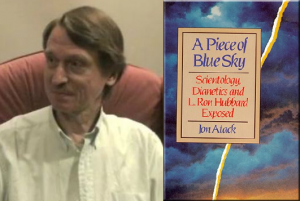 In 1990, author Jon Atack published what is still one of the very best books on L. Ron Hubbard and Scientology, A Piece of Blue Sky. Atack now has a new edition of the book out, and it reminded us what an encyclopedic resource he is. So we had an idea. In the world of Scientology watching, we noticed that there seem to be some legends, myths, and contested facts that tend to get hashed and rehashed in books, articles, and especially on the Internet. With Atack’s help, we’re going to tackle these issues one by one, drawing on Jon’s deep knowledge.
In 1990, author Jon Atack published what is still one of the very best books on L. Ron Hubbard and Scientology, A Piece of Blue Sky. Atack now has a new edition of the book out, and it reminded us what an encyclopedic resource he is. So we had an idea. In the world of Scientology watching, we noticed that there seem to be some legends, myths, and contested facts that tend to get hashed and rehashed in books, articles, and especially on the Internet. With Atack’s help, we’re going to tackle these issues one by one, drawing on Jon’s deep knowledge.
This week, we try to clear up Scientology’s origin, which journalists sometimes disagree on.
Jon, there was a fascinating story in Newsweek/The Daily Beast recently about a trove of L. Ron Hubbard documents at New York’s Explorers Club. The article had some new information that tended to corroborate what you and other Hubbard historians have written over the years.
However, there was one line that I wanted to bring to your attention. About halfway through the article, there’s this assertion: “In 1954 Hubbard founded the Church of Scientology, opening his first congregation in Los Angeles.”
“Congregation” is a funny word for Scientology, but we’re also curious about the assertion that Hubbard first founded a “church” of Scientology in Los Angeles in 1954. That fact is often presented by people who write about Scientology, and even Lawrence Wright said as much in his book Going Clear.
But it was in 1952 that Scientology rose from the ashes of the Dianetics movement, after Hubbard’s first round of “foundations” and other organizations had flamed out. And in his 2011 scholarly treatment of Scientology history, Ohio State University professor Hugh Urban pointed out that Hubbard wrote to a friend that he was going to try “the religion angle” and then founded a “church” of Scientology in Camden, New Jersey in 1953.
So which is it? When should we date the formation of the “Church of Scientology?” 1952, 1953, or 1954?
ATACK: Scientology came into being in February 1952 after the original Dianetics movement had fallen apart. Hubbard had resigned from the Wichita Foundation, believing that the bankruptcy of the first foundation and a New Jersey Medical Association lawsuit would impact on him. So he sold all rights to Dianetics to Kansas millionaire Don Purcell for a dollar. Purcell managed to buy it all back from the bankruptcy court, but by this time, as he tended to do, The Hub had fallen out with Purcell, so he had to come up with something new for the few remaining true believers — and thus, Scientology was born.
With Scientology, The Hub was finally able to introduce the material he’d long been interested in — entities and past lives. He needed to make Scientology new and avoid anything he’d already done, so he relied mainly on his old occult mentor, Aleister Crowley. When I came to write about The Hub’s plagiarism, of 120 proveable examples — where he had not only used an idea, but also referred to the source of that idea — fully half came from Crowley’s Magick in Theory and Practice. This is undoubtedly the book The Hub was referring to in the December 1952 Philadelphia ‘Doctorate’ Course lecture, which he calls The Master Therion (Crowley’s ‘magickal’ name, and not the title of a book). Even though 150,000 copies of Dianetics had been sold by that point, there were only 38 people on the PDC, an indication of how much the original 1950 Dianetics craze had died down.
The notorious ‘religion angle’ letter was written on April 10, 1953 — to the organizer of the PDC, Hubbard’s then deputy, Helen O’Brien (whose book will break any heart, she was so shabbily treated by The Hub). Here’s what Hubbard wrote to her:
We don’t want a clinic. We want one in operation, but not in name. Perhaps we could call it a Spiritual Guidance Center. Think up its name, will you? And we could put in nice desks and our boys in neat blue with diplomas on the walls and one, knock psychotherapy into history and, two, make enough money to shine up my operating scope, and, three, keep the HAS [Hubbard Association of Scientologists] solvent. It is a problem in practical business.
I await your reaction on the religion angle. In my opinion, we couldn’t get worse public opinion than we have had or have less customers with what we’ve got to sell. A religious charter would be necessary in Pennsylvania or N.J. to make it stick. But I sure could make it stick. If we were to return there [to Phoenix] we’d be able to count 10 to 15 preclears per week at $500 for 24 hours processing. That is real money. I have seen it happen before. We get more preclears at $850 per week [counseling] intensive. Charge enough and we’d be swamped. We need that money. We should not long plan to have it siphoned away.
Bless him. Ever the philanthropist. Hubbard registered his three ‘churches’ in December 1953, in Camden, New Jersey, calling them the Church of Scientology, the Church of American Science, and the Church of Spiritual Engineering. His use of the word ‘church’ was deliberate. At the time, it meant a Christian organization. He wrote elsewhere that the Church of American Science was intended to recruit Christians and move them over into Scientology.
To distance himself, The Hub had Burton Farber register the “Church of Scientology of California” in Los Angeles a few months later, in February 1954, and subsequently claimed that it was not his idea (though the letter to O’Brien, which has been authenticated by the cult, shows that this was yet another fraud). Lawrence Wright accepts the claims in Science of Survival that others persuaded The Hub about reincarnation and the nature of the spirit. A quick study of Crowley (and perhaps my paper on plagiarism) shows that The Hub was actually waiting for his chance to introduce these ideas. Losing Dianetics was that chance. Purcell foolishly gave it back to him, later. It would have been better to lock it up and throw away the key.
Around 1968, the Minister’s Course was introduced. People who were on the first one — and it was required for all staff — told me that it was to prevent staff from being drafted into the Vietnam War. This is when the Ceremonies book was published (which has some of the best Vogon poetry ever written) and the dog collars and silver crosses were first worn. In nine years, I only attended one ‘church service’ — a wedding. When I was at Saint Hill in about 1975 I asked about the Sunday service and was told that no one attended it, but it was necessary to the repeated applications for charitable status. I never for a moment thought I was part of a ‘religion.’ Scientology is a mystery cult in the proper and original meaning of the word ‘mystery’ — a series of initiations that supposedly reveal profound truths. And, as with the Greek mystes, the Mithras cult which greatly influenced early Christianity, or the gnostic sects with their passwords for the planets — as with all of these, Scientology is bogus.
As to the ultimate question, is Scientology a religion? I think the question is rather, is there such a thing as a bad religion? If an anti-social group that encourages hatred, intolerance, and vengeful spite can be a religion, then Scientology is a religion. But it is a Suppressive Religion. It is a bad religion. And governments that increase its destructive power are bad governments. Janet Reitman tried to persuade me that it is a religion because the IRS says it is. That, and the fact that members believe it is, was sufficient for her. But the US government cannot make any determination about the religious nature of any group. It is bound by the Constitution. So, while the IRS can say that they believe Scientology exists for the benefit of society (!) and should have non-profit status, it can’t say a single word about its religion status. And just because someone worships their pet rock doesn’t mean that I have to accept they’ve fulfilled the criteria for religion. I also take issue with Frank Flinn’s statements during the Gerry Armstrong trial, which Lawrence Wright uses as his whole basis for affording religious status to the cult.
And that’s all I have to say about that. At least for now.
THE BUNKER: Let us throw another complication into the mix. In 1955, Hubbard started a church in Washington DC that is, to this day, referred to by Scientology itself as “the original founding church of Scientology.” How does that fit into the picture?
ATACK: Because he feared that the ‘religion angle’ would turn out to be unpopular, Hubbard distanced himself from it by keeping his original 1953 New Jersey registrations secret. I don’t think anyone noticed them until Roy Wallis did in the 1970s.
Hubbard then had Burton Farber register the Church of Scientology of California a few months later, in 1954, to see what the reaction would be. To assert his control, once he knew that he wouldn’t be drawn and quartered for launching a new religion, Hubbard then created the Founding Church in DC, and at the same time made himself The Founder. The idea was to oversee the religious outlets, while the Hubbard Association of Scientologists existed alongside, in case the material had to be quickly moved under that shell.
When I worked out the corporate structure for the US courts, I was surprised to find that there were some 400 separately registered corporations, and really no such legal entity as ‘The Church of Scientology.’ This complex network was initiated by Hubbard to create different vessels, in case one should sink (as the orginal Hubbard Dianetic Research Foundation had, under pressure from the New Jersey Medical Association). When Lawrence Wollersheim broke the last obstacle to claiming his millions, he was told that the Church of Scientology of California — the ‘mother church’ — had insufficient funds to meet the claim. My corporate monolith argument was wheeled in, and the judge accepted that the many ‘churches’ were simply compartments of the same organization, with signed and undated resignations held by the leadership to maintain control. The Founding Church seems to have been an early attempt at keeping the assets safe.
THE BUNKER: Well, that’s quite a litany of foundings. But if you had to provide a single date for the formation of the “Church of Scientology,” would you say February 1952 in Phoenix, December 1953 in New Jersey, February 1954 in Los Angeles, or July 4, 1955 in Washington DC?
ATACK: The first incorporated Church of Scientology was registered, by Hubbard, in Camden, New Jersey in December, 1953.
THE BUNKER: Well there you have it. And this December, we’ll give a hip, hip, hooray for 60 years.
——————
Posted by Tony Ortega on February 8, 2013 at 07:00






